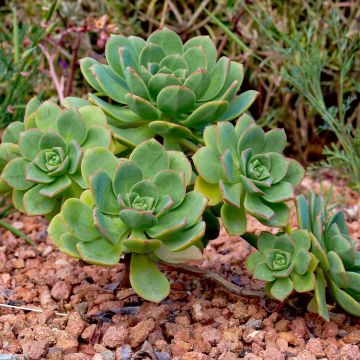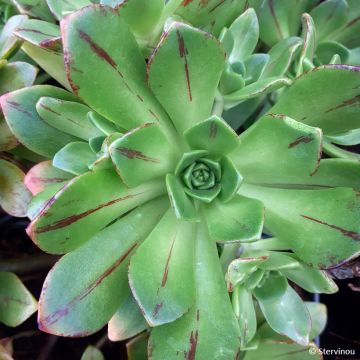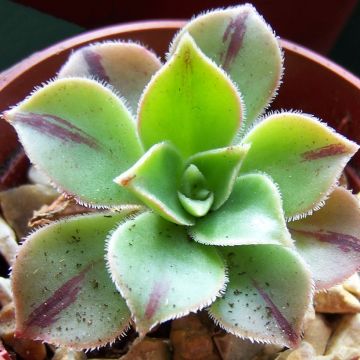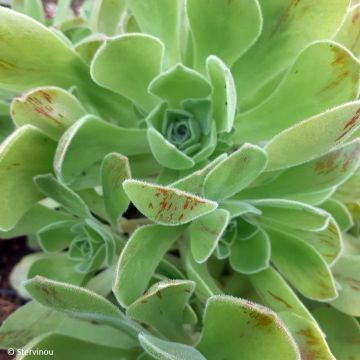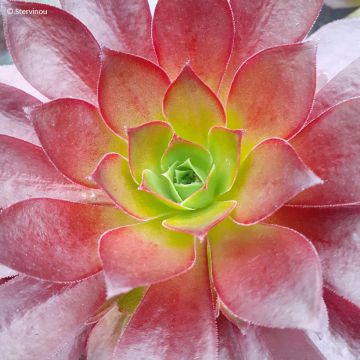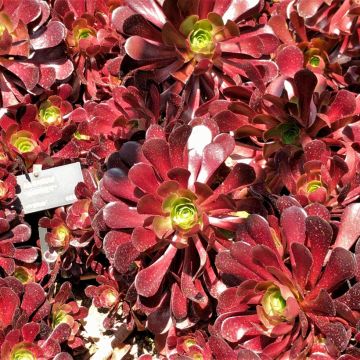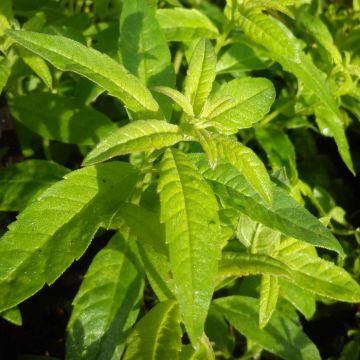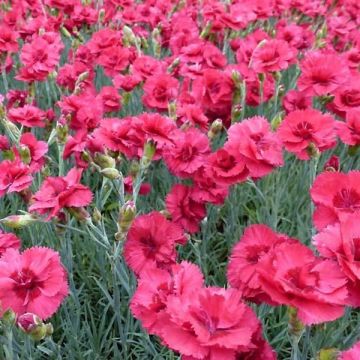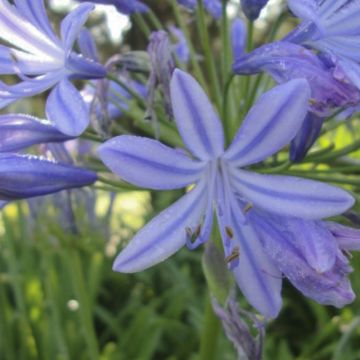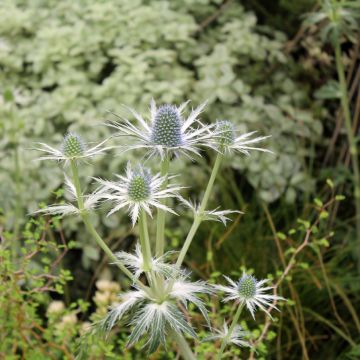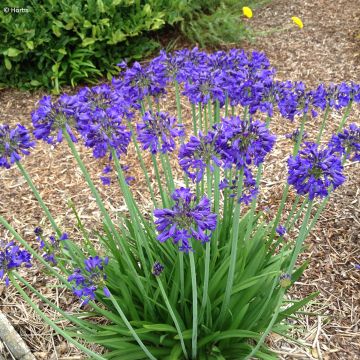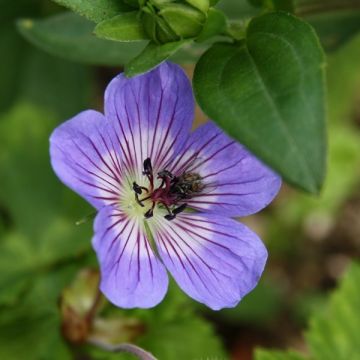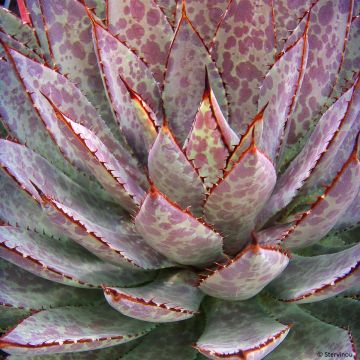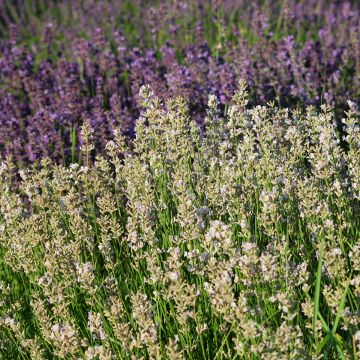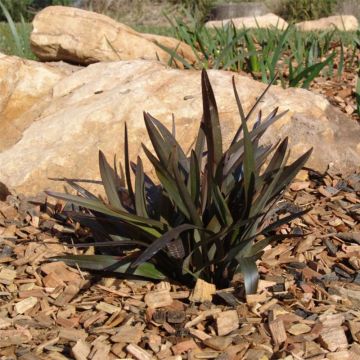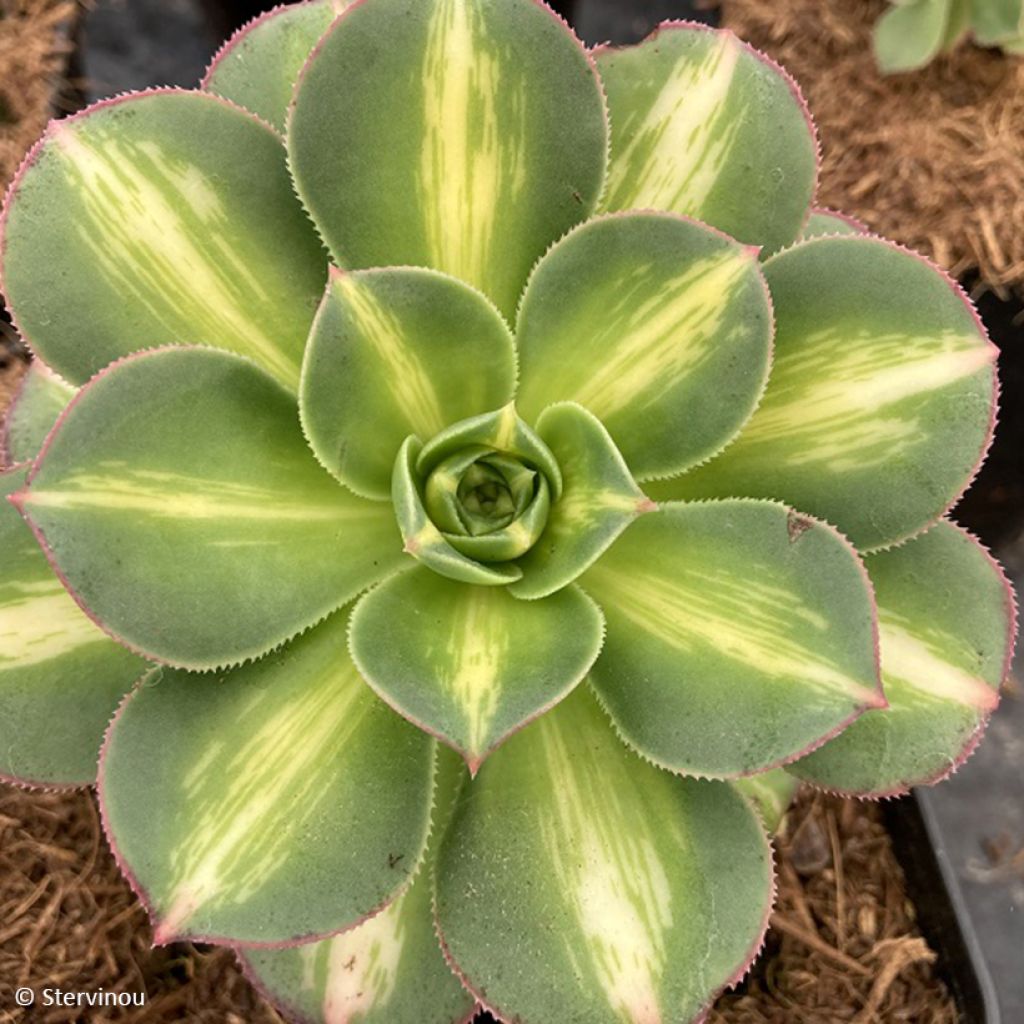

Aeonium Starburst
Aeonium Starburst
Aeonium percarneum var. guiaense x mascaense. Starburst
Tree Aeonium, Tree Houseleek, Irish Rose
Why not try an alternative variety in stock?
View all →This plant carries a 24 months recovery warranty
More information
We guarantee the quality of our plants for a full growing cycle, and will replace at our expense any plant that fails to recover under normal climatic and planting conditions.
From €5.90 for pickup delivery and €6.90 for home delivery
Express home delivery from €8.90.
Does this plant fit my garden?
Set up your Plantfit profile →
Description
Aeonium 'Starbust' is a spectacular and attractive variety, with a bushy habit. Over time, it forms a small tree-like shrub resembling a bonsai with its "trunk" and short branches bearing the characteristic rosettes of the species. These rosettes are remarkable for their size, which can reach 40 cm in diameter. They are also eye-catching with their gorgeous yellow on green variegation, giving a luminous aspect to the plant. Tolerating brief frosts down to -3°C/-4°C, it can be planted in full sun in the south, under light shade in very hot regions. Plant it in a pot elsewhere to overwinter it indoors.
Aeonium is one of the 30 members of the Crassulaceae family, which hosts nearly 1400 species. These plants, often of small stature, are particularly adapted to drought, thanks to their unique metabolism within the plant kingdom. Many of them share a resemblance with their rosette leaf arrangement, such as the Sempervivum (Houseleek), well-suited to cold weather, or the Aeoniums, most of which come from the warm climate of the Canary Islands. The genus also includes numerous hybrids and horticultural varieties like 'Starbust', previously known as 'Lemon Lime'.
This cultivar appears to be a reversion of the 'Sunburst' variety which has an exactly opposite colouration, with a green central part bordered by a yellow margin. Some plants have been found bearing both variegations, validating this hypothesis (normally, a reversion involves the loss of variegation, with the plant reverting to the original green type). These hybrids are believed to be the result of a cross between A. mascaense, a highly branched bushy species native to Tenerife, and A. percarneum var. guiaense, another botanical species from the island of Gran Canaria. 'Starbust' adopts a tree-like silhouette, able to grow up to 70 cm in height over time. A specimen planted in the ground will commonly reach 50 cm in height and 40 cm in width within 10 years of planting and will continue to grow thereafter. The leaves are broadly spatulate, narrow at the base where they attach, widening significantly in the upper third to round off at the tip with a slight point. Their edges are finely serrated in micro-dentations, and they are imbricate, overlapping each other in the typical fashion for these plants. What is slightly unusual is the diameter the rosettes can reach, with the largest ones measuring up to 40 cm. It is possible to encourage the growth of the largest ones by removing some of the smaller ones. Adorned in a beautiful mint green colour, the leaf blade sports a yellow central band with irregular edges, creating a striking contrast. Depending on the light, a pink-red edging may also develop, enhancing the leaf and rosette patterns. Although rare, the plant may produce a summer flowering of white-yellow small flowers on a floral stem rising above the rosette.
Planted in a rockery in a mild climate with little frost, Aeonium 'Starbust' will undoubtedly attract attention in the garden with its beautiful variegation magnified by the large rosettes. You can create an even more striking scene by planting alongside it an Aeonium 'Schwartzkopf' with rosettes of an almost blackish purple that will contrast vividly with the green and yellow variegation. To maintain strong contrasts, add a specimen of the fabulous Senecio mandraliscae, whose bluish claws will gradually cover the ground, and if its delicate light yellow inflorescences seem too pale, choose from the range of Delosperma, creeping perennials with countless flowers boasting vibrant colours.
Report an error about the product description
Plant habit
Flowering
Foliage
Botanical data
Aeonium
percarneum var. guiaense x mascaense.
Starburst
Crassulaceae
Tree Aeonium, Tree Houseleek, Irish Rose
Aeonium Lemon Lime
Cultivar or hybrid
Other Aeonium
Planting and care
Aeonium 'Starbust' is resistant to heat and drought and needs light, well-drained, sandy, poor soil, even slightly limestone. Plant it in spring, after the last frosts, in the ground, in a coastal, mild, or hot and dry climate. It can be grown in pots all year round, sheltered from frost of course. It thrives in the sun where it will take on the most beautiful colours, but will appreciate some shade in the south as its variegated foliage can be sensitive to excessive sunlight. Originally from the Canary Islands, it is sensitive to cold from -3°C and can only be planted outdoors in a very mild climate, where frost is occasional and not intense. Overwinter this plant in an unheated, but frost-free and very bright room. Water moderately from autumn to spring, and sparingly in summer, the plant's rest period. Remove faded inflorescences and dead branches.
Planting period
Intended location
Care
This item has not been reviewed yet - be the first to leave a review about it.
Mediterranean perennials
Haven't found what you were looking for?
Hardiness is the lowest winter temperature a plant can endure without suffering serious damage or even dying. However, hardiness is affected by location (a sheltered area, such as a patio), protection (winter cover) and soil type (hardiness is improved by well-drained soil).

Photo Sharing Terms & Conditions
In order to encourage gardeners to interact and share their experiences, Promesse de fleurs offers various media enabling content to be uploaded onto its Site - in particular via the ‘Photo sharing’ module.
The User agrees to refrain from:
- Posting any content that is illegal, prejudicial, insulting, racist, inciteful to hatred, revisionist, contrary to public decency, that infringes on privacy or on the privacy rights of third parties, in particular the publicity rights of persons and goods, intellectual property rights, or the right to privacy.
- Submitting content on behalf of a third party;
- Impersonate the identity of a third party and/or publish any personal information about a third party;
In general, the User undertakes to refrain from any unethical behaviour.
All Content (in particular text, comments, files, images, photos, videos, creative works, etc.), which may be subject to property or intellectual property rights, image or other private rights, shall remain the property of the User, subject to the limited rights granted by the terms of the licence granted by Promesse de fleurs as stated below. Users are at liberty to publish or not to publish such Content on the Site, notably via the ‘Photo Sharing’ facility, and accept that this Content shall be made public and freely accessible, notably on the Internet.
Users further acknowledge, undertake to have ,and guarantee that they hold all necessary rights and permissions to publish such material on the Site, in particular with regard to the legislation in force pertaining to any privacy, property, intellectual property, image, or contractual rights, or rights of any other nature. By publishing such Content on the Site, Users acknowledge accepting full liability as publishers of the Content within the meaning of the law, and grant Promesse de fleurs, free of charge, an inclusive, worldwide licence for the said Content for the entire duration of its publication, including all reproduction, representation, up/downloading, displaying, performing, transmission, and storage rights.
Users also grant permission for their name to be linked to the Content and accept that this link may not always be made available.
By engaging in posting material, Users consent to their Content becoming automatically accessible on the Internet, in particular on other sites and/or blogs and/or web pages of the Promesse de fleurs site, including in particular social pages and the Promesse de fleurs catalogue.
Users may secure the removal of entrusted content free of charge by issuing a simple request via our contact form.
The flowering period indicated on our website applies to countries and regions located in USDA zone 8 (France, the United Kingdom, Ireland, the Netherlands, etc.)
It will vary according to where you live:
- In zones 9 to 10 (Italy, Spain, Greece, etc.), flowering will occur about 2 to 4 weeks earlier.
- In zones 6 to 7 (Germany, Poland, Slovenia, and lower mountainous regions), flowering will be delayed by 2 to 3 weeks.
- In zone 5 (Central Europe, Scandinavia), blooming will be delayed by 3 to 5 weeks.
In temperate climates, pruning of spring-flowering shrubs (forsythia, spireas, etc.) should be done just after flowering.
Pruning of summer-flowering shrubs (Indian Lilac, Perovskia, etc.) can be done in winter or spring.
In cold regions as well as with frost-sensitive plants, avoid pruning too early when severe frosts may still occur.
The planting period indicated on our website applies to countries and regions located in USDA zone 8 (France, United Kingdom, Ireland, Netherlands).
It will vary according to where you live:
- In Mediterranean zones (Marseille, Madrid, Milan, etc.), autumn and winter are the best planting periods.
- In continental zones (Strasbourg, Munich, Vienna, etc.), delay planting by 2 to 3 weeks in spring and bring it forward by 2 to 4 weeks in autumn.
- In mountainous regions (the Alps, Pyrenees, Carpathians, etc.), it is best to plant in late spring (May-June) or late summer (August-September).
The harvesting period indicated on our website applies to countries and regions in USDA zone 8 (France, England, Ireland, the Netherlands).
In colder areas (Scandinavia, Poland, Austria...) fruit and vegetable harvests are likely to be delayed by 3-4 weeks.
In warmer areas (Italy, Spain, Greece, etc.), harvesting will probably take place earlier, depending on weather conditions.
The sowing periods indicated on our website apply to countries and regions within USDA Zone 8 (France, UK, Ireland, Netherlands).
In colder areas (Scandinavia, Poland, Austria...), delay any outdoor sowing by 3-4 weeks, or sow under glass.
In warmer climes (Italy, Spain, Greece, etc.), bring outdoor sowing forward by a few weeks.

































